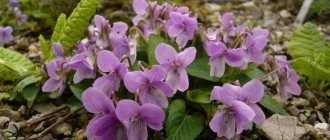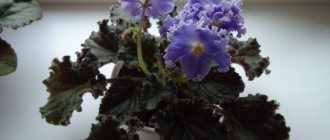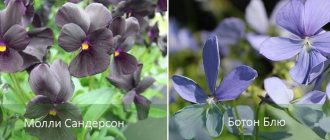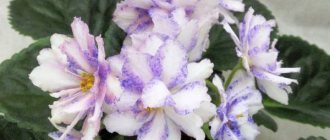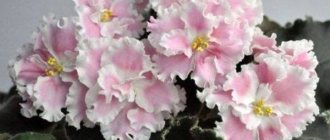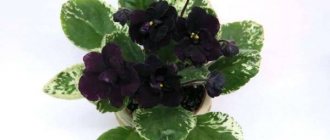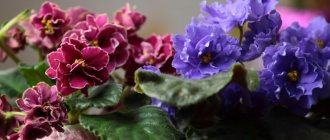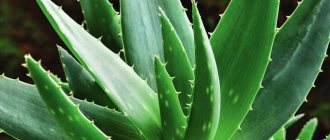Fragrant violets are valued for their wonderful aroma, and also for a fairly simple and at the same time lovely appearance. The Royal Violet variety is very common due to its particularly strong aroma and delicate color.
The plant and grows very easily But it is important to take into account the preferences of the bush to obtain the most beautiful and fragrant flowers. Next you will see a description and photo of the Tsarskaya fragrant violet variety.
Fragrant violet
Fragrant violet has several varieties with a bright aroma ; you can see pictures of some of them below:
- Bechtles Ideal – large-flowered variety, lilac color;
- Coeur d'Alsace – pink color;
- Christmas – white;
- Czar and Tsarskaya – lilac, one of the most fragrant;
- Konigin Charlotte – large dark purple;
- Red Charme – red-purple color;
- Triumph - purple and largest flowers.
All varieties have similar parameters - they are perennial herbaceous flowers, rounded leaves with a heart-shaped base. The flowers are solitary, located on tall thin peduncles; the size and color of the flowers varies depending on the variety.
Distribution area
In nature, the violet grows in Europe, mainly in the west and center .
It usually grows in deciduous forests, preferring edges, clearings and clearings, and is also found on forested mountain slopes.
It usually grows on fertile soils , such as deciduous soil in forests and black soil on roadsides and forest edges.
It is not demanding in terms of lighting, can tolerate direct sunlight, and also grow in shade and partial shade.
Variety "Tsarskaya"
The fragrant violet belongs to the genus of violets (viola), family Violet , order Malpighiaceae, class dicotyledonous. Tsarskaya is one of the varieties of fragrant violas, which is quite widespread due to its simplicity and unsurpassed aroma.
Fragrant Royal Violet is a perennial whose stems retain their green color even in winter. The stems are thick, creeping rhizomes that bear leaves and flower stalks in the spring.
The leaves are heart-shaped at the petiole and pointed at the ends; the edge is usually rounded, but can sometimes be slightly jagged. The color of the leaves changes during growth - young ones are lighter, and the older ones are darker, and can also change depending on the lighting.
Violet Fragrant Royal.
Peduncles appear from the axils of the leaves, they are long and one bud is formed on each.
The flowers have a double perianth, clearly divided into a corolla and a calyx, each petal being free.
The petals are dark purple, there are five of them on each flower , the lowest one is slightly larger than the others and has a spur, usually three petals are directed downwards, two more upwards.
Important! The fragrant royal violet is the most fragrant variety among violas. Flowers of this variety can predict the weather - before the rain they lower their heads and close their petals.
Spreading
Where does the Tricolor Violet live? A very common plant all over the world. It is even considered a weed and an alien. These flowers have been growing for many centuries without human intervention.
In ancient times it was a symbol of Athens. So it turns out that their homeland is the entire northern hemisphere of Eurasia.
This flower is known in numerous territories. Both with a temperate climate and with a severe climate:
- It is more difficult to name places where they are not found in Western Europe. Except that you rarely see it on the Mediterranean coast. They are even the floral symbols of the provinces in Sweden;
- And imagine a vast area between two lines: 1st. From Murmansk to Tobolsk. Through Kirovsk, Kandalaksha, Pechora, Vorkuta and Yekaterinburg;
- 2nd. From the Carpathians to Chelyabinsk. Through Chisinau, Odessa, Zaporozhye, Donetsk, Rostov-on-Don, Volgograd, Samara, Orenburg;
- And also the Krasnoyarsk Territory, Altai, the Far East, Crimea.
We suggest you read: Why does diarrhea occur in chickens and its treatment?
Important! All these are places where this violet grows in the post-Soviet space.
Habitat
Its entire blooming colonies are everywhere you can find:
- In the meadows;
- In numerous bushes;
- In clearings and forest edges;
- On former pastures;
- In old parks and gardens;
- Near roads;
- The will of abandoned houses and estates.
This perennial herbaceous plant, which is small in size, is common in Europe, Asia, and northern Africa. In the vastness of Russia, it can be found in the European part and in Transcaucasia.
Fragrant violet prefers deciduous forests. It loves edges, clearings and forms picturesque dense thickets that cover the soil with a dense, beautiful carpet.
Growing from seeds
small seeds are formed in small boxes (length approximately 1.5 mm, thickness - 1 mm). In nature, they are carried by ants and this is how the plant spreads.
If we talk about growing from seeds, when to plant depends on how you are going to do it - seedlings or non-seedlings.
Seedling method
To plant seeds for seedlings, they must be prepared , because good similarity is maintained only for the first two weeks.
Preparations begin in February and the process consists of:
- Seeds are sown in prepared soil. The substrate is made up of peat/leaf soil/perlite/vermiculite/sphagnum moss/charcoal in a ratio of 2/1/1/1/0.5, or purchase a ready-made mixture for Saintpaulias (Usambara violets);
- The seeds are sown on the ground, without sprinkling, and sprayed with a spray bottle, then covered with film ;
- The temperature at this stage is 18-20°C . Periodically, the film is lifted for ventilation and spraying , as necessary. This care is maintained for 2-3 weeks ;
- The next stage is stratification . To do this, the containers are moved to a cold room or refrigerator with a temperature of -4 to 4°C . Then wait 4-6 weeks or until the first shoots appear (whichever is faster);
- Afterwards, the temperature is raised to 5-12°C , and watering must be resumed, but only to maintain low humidity;
- After the appearance of the first full leaf, if necessary, the plants are planted in separate flowerpots ;
- Further care involves a temperature of about 20°C and moderate watering ;
- The seedlings are transferred to the ground in August and must be covered for the winter.
Sowing seeds for seedlings is a rather labor-intensive process, and if you have your own seeds, it is easier and more efficient to sow them for the winter.
Without seedlings
Fresh seeds are sown within two weeks after collection in small furrows and mulched with peat or humus. The sowing period falls approximately at the end of August - mid-September .
The following spring, shoots appear; after the appearance of two permanent leaves, picking is carried out as necessary .
Spring shoots of viola.
Picked bushes grow until August-September, and then they are planted in a permanent place. For the winter it is necessary to cover young plants . The first flowering usually appears in the second year.
Morphological description
There are many varieties of violets. But there is a lot that unites them in the structure. Many people tend to see a human figure in the structure of the violet. And they say that it symbolizes reflection:
- Life form – terrestrial herbaceous plant: Annual or biennial;
- More - therophytes. They survive unfavorable periods (seasons) by seeds. Typically annuals;
- There are also hemicryptophytes.
One or more of them grow from the root: vertical or creeping. Branched, triangular and hollow inside; Violet Tricolor has an unusual structure.
- Below - elongated oval;
- The green cup of five leaves does not fall off after flowering. It is also noticeable with the seed pod;
There are many different varieties of Tricolor Violet.
One photo cannot give an idea of the numerous varieties of violets. This is a typical representative of their family.
We suggest you read What can be made from a tree root
Plant care rules
This flower feels most comfortable in well-lit areas with fertile soil . In shaded places, the bush can grow fully, but the abundance of flowering will decrease, and with excess moisture there is a danger of rotting.
Watering for fragrant violets is not a necessary procedure, because the bush survives even in drought, but without moisture, flowering will be very poor or will not occur at all, and the risk of damage by spider mites also increases. Irrigate the soil only when necessary , avoiding the appearance of puddles.
Feeding is carried out during the period of active growth , if desired by the owner. It is recommended to use mineral fertilizers, since the plant reacts extremely negatively to the application of fresh organic fertilizers.
If necessary, trim the shoots , removing rotten, dried and excess parts. At the same time, you can propagate the bush using the vegetative method. To do this, the healthy part of the stem-root is removed from the mother plant.
When replanting, it is important to minimally damage the root system, given the placement of the main root on the surface of the soil, it is recommended to cut the bush before digging it up (if necessary or desired).
To rejuvenate the old individual, it is also shaved, leaving a rather small young ponytail.
Cultural forms
The most common and popular varieties:
- Coeur d'Alsace - decorative form with pink inflorescences;
- Bechtles Ideal – violet with large blue flowers;
- Queen Charlotte is a plant (hybrid) with large lilac flowers;
- Foxbrook Cream - violet with white flowers and a yellow center;
- Red Charm is a perennial violet with lilac inflorescences with a burgundy core (suitable for growing at home).
Features of flowering
The buds are single, on thin long peduncles that form in the axils of the leaves. Like most violets, fragrant has a flower division into lower and upper segments , three petals below, the central one wider and larger than the others, two equal at the top.
The color of the fragrant royal violet is purple, sometimes lighter or darker , depending on the lighting and conditions. A special feature of the flowers of this variety is their unusually bright and strong aroma .
Flowering occurs in April-May for 20-25 days , sometimes re-blooming at the end of summer. Each bud lasts almost the entire flowering period. The flowers themselves are very sensitive to precipitation and before the rain they usually droop and close their petals tightly .
Fragrant violet flower.
In landscape design it is widely used in different variations:
- for forcing - they are taken into a pot for the winter and in the spring they get very early flowering;
- spring flower beds - planted in combination with other early-blooming flowers;
- as a ground cover plant - in places where it is necessary to completely cover the soil;
- in alpine hills - the flower grows and can grow as a beautiful waterfall on the hill;
- on borders - as well as for flower beds, this variety is perfect;
- often grown in pots, because the plant grows well in such conditions.
Bush division and cuttings
Let's skip propagation using seeds and consider two methods based on the goal of vegetative propagation of a plant. For example, bush division rejuvenates the violet and prevents its death; cuttings allow you to propagate even one bush.
Dividing bushes
Dividing should be done in the spring - before flowering or in the summer - after flowering. Part of the bush is cut off with a knife or scoop, having previously cut off the remaining flowers, and planted in a new area, preferably in moist, well-draining soil, under the shade. Used for fragrant violets and pansies.
It is convenient to do this after rain. The plant takes root quickly. In the fall, the new bush will be able to bloom, and in the winter it will form a rhizome.
Cuttings
Most often, cuttings are taken from May to July - this is the most favorable period for this type of propagation. After the flowers become smaller and the bushes grow too much, you need to cut off the top shoots with 2-3 nodes. They need to be rooted 2 or 3 weeks after cutting. But they take root quite easily and by the end of summer - beginning of autumn you will be able to see the lovely blooming of violets. Also read our article about indoor violets “Uzambara violet - cultivation and care”
Similar articles:
Badan - photos of varieties, descriptions, tips for growing and caring
Silver cineraria - tips for growing and...
18 flowers similar to daisies - description and...
Application in medicine
For medicinal purposes , both the above-ground part and the roots are used . Has a large number of medicinal properties:
- expectorant;
- preventing neoplasms;
- choleretic;
- anti-inflammatory;
- diaphoretic;
- soothing;
Used for many diseases, among which are:
- urolithiasis;
- diseases of the bronchi and lungs;
- headache;
- nervous exhaustion and breakdowns;
- skin diseases;
- some forms of cancer, as an adjuvant.
Annuals
The root system of annual violets is fibrous, that is, there is no main root, but there are a great many small roots. They penetrate the top layer of soil with a wide network and do not go deep into it. The stems are branched; each branch usually bears several flowers. The annual flowers are very large, reaching 10 cm. The annual garden violet is a neat decorative bush up to 20 cm in height.
The most popular types are the following:
- Chalon Supreme is a series of varieties with ruffled seven-centimeter flowers of extraordinary beauty.
- Rose Shades is a variety with soft pink petals and a purple central spot.
- Cherry Pie Mix - purple or maroon flowers with a white border.
- Flame is a variety with fiery red flowers edged with orange.
- Cats is an interesting series of varieties. It differs in that in the center of the flower there is a pattern similar to a cat’s face.
- Jema is a series designed specifically for hot regions.
Recipes
Violet herbal tea
Pour 2 teaspoons of herbs into 1/4 liter of water, bring to a boil and leave for 5 minutes. After straining, drink a cup 2-3 times a day (for coughs, sweeten with honey). For rinses and skin lotions, use undiluted.
In folk medicine, fragrant violet tea is used to cleanse the blood and for dry bronchitis. In the latter case, syrup is preferable.
Fragrant violet syrup
Place 1 full cup of fresh violet herb in a bottle, pour 1/4 liter of hot water into it and leave for a day, then filter. The strained liquid is drained, heated to a boil, a new portion (1 full cup) of violet flowers is added and again left for 24 hours. After filtering, the resulting infusion is mixed with honey in equal parts and given to children 1 teaspoon for cough. Sometimes violet flowers are prescribed as a means to calm the nerves. They should be very fresh and should be eaten with orange marmalade.
Bronchitis, whooping cough
- 1 tbsp. pour fragrant violets with 1 cup of boiling water, leave for 30 minutes, strain. Take 1/2 cup 2 times a day.
- Pour 50 grams of crushed fragrant violet herb with flowers into 1 glass of boiling water, leave for 1 day, strain. Add 200 grams of sugar to the resulting liquid and heat until completely dissolved. Give children 1 tsp. syrup 4 times a day.
- Pour 2 grams of fragrant violet into 1 glass of boiling water. Put on fire for 10 minutes. Give children 1 tbsp. every 2 hours throughout the day. Cover the upper part of the child's chest with grass cake and bandage it so that you get a warm compress.
Increased heart rate, hysteria
Pour 2 teaspoons of chopped herbs and fragrant violet roots into 1 glass of boiled water, leave in a cool place for 8 hours, strain. Take 1 tbsp. 4 times a day.
Kidney-urolithiasis
In folk medicine for urolithiasis, the following collection is used:
- fragrant violet (plant) -80 g;
- beans (leaves) -20 g;
- bearberry (leaves) -20 g;
- corn (stigma) -20 g;
- birch (buds) -20 g
Pour 2 tablespoons of this mixture into 400-800 g of boiling water, leave for 20 minutes and filter. Take 2-3 tablespoons 3 times a day.
Enuresis
People use the following collection for enuresis:
- fragrant violet (herb) - 1 part;
- sage (leaves) - 2 parts;
- yarrow (herb) - 1 part;
- snapdragon (herb) - 2 parts;
- blueberries (leaves) - 2 parts;
- St. John's wort (herb) - 2 parts;
- blue cyanosis (grass) – 2 parts
Pour 3 tablespoons of the crushed mixture into 1 liter of boiling water, boil for 30-40 seconds, leave for 1 hour and filter. Take 50 g 6 times a day.
ATTENTION! All recipes are provided for informational purposes only. Before use, consult your doctor!
